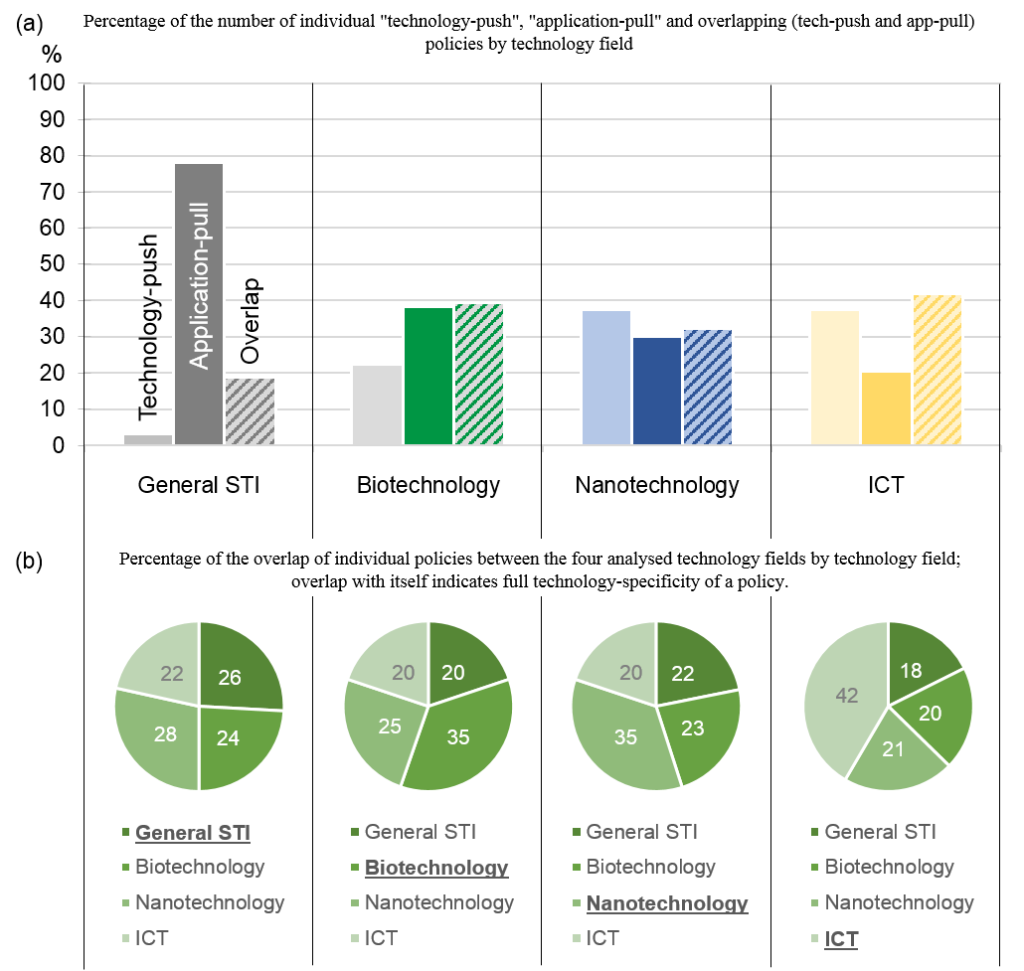“The young ones need a bit of a push!”
… that, at least, seems to be the credo followed by policy makers tasked with the development of initiatives and strategies that foster the advancement of specific fields of science and technology, as was revealed by a recently published “Trend-analysis of science, technology and innovation policies for BNCTs”. Steffi Friedrichs, author of the OECD study found that, in general, technology-push policies seem to be favoured for young technology fields, while application-pull policies tend to be applied to more mature fields.
The concept of “technology-push” versus “application-pull” is akin to (but not entirely identical with) that of “basic” versus “applied” science and technology; the former describes a policy’s focus on a technology field (or sub-field) versus its directionality towards a specific application. The following figure illustrates the orthogonality between the concepts of basic versus applied and technology-push versus application-pull.

[Source: Steffi Friedrichs, OECD STI Working Papers 2018/08]
The distinction of a policy to be either of technology-push or of application-pull directionality, combined with that of the policy’s generality (i.e. is a policy focused on one technology field only or is it applicable to a wide range of technologies) is directed along innovation value-chains, while the differentiation between basic and applied research acts perpendicular to the value-chains. In other words, the categories assigned in this report identify individual strands of innovation value-chains that separate technologies from each other and that may further separate or merge along a value-chain, while the concept of basic versus applied research separates an innovation value-chain into distinct stages.
The Motivation
Countries and regions are dedicating significant investments to the advancement of biotechnology, nanotechnology and ICT (information and communication technology).
“Not every policy instrument is equally well-suited to create high economic impact from emerging technologies.”
[Steffi Friedrichs, OECD STI Working Papers 2018/08]
Recent comparative studies of the impact of policies, however, suggest that not every policy instrument is equally well-suited to create high economic impact from emerging technologies. Science, Technology and Innovation (STI) policy making could be significantly strengthened and advanced in both the speed and the ex ante assessment of their impact, if it was possible to determine a pattern of change in STI policies with growing maturity and development of the technologies they address.
The OECD set out to obtain an overview of the existence of national technology-specific policies and policy instruments for biotechnology, nanotechnology and ICT. In addition to analysing the longitudinal development of the number of policies pertaining to the advancement of the three technology fields over the past years, the authors aimed to obtain an insight into the directionality (i.e. technology-push versus application-pull) of such policies. The main questions asked at the onset of the analysis were:
- Have the number of STI policies that specifically aim to support the advancement of biotechnology or nanotechnology changed over time and with growing maturity of the technologies?
- Have the technology-specificity or the directionality of STI policies or the policy instruments they employ changed over time?
In its focus on the directionality and technology-specificity of policies, the OECD analysis is strictly an ex ante approach, because it considers the description of policies only, while their resulting impact is not being investigated. In this regard, it needs to be noted that application-pull policies can lead to basic research (i.e. technology-push) results, and vice versa.
The Findings

[Source: Steffi Friedrichs, OECD STI Working Papers 2018/08]
Most STI policies are technology-specific (i.e. the number of policies assigned to biotechnology, nanotechnology and/or ICT is around 20% higher than that assigned to the field of general STI). The few general STI policies identified by the study, also mention a specific technology and are thus applicable to both the field of general STI and the field of the technology. In the case of biotechnology, nanotechnology and ICT, by contrast, at least one third of the policies are unique to the respective field, and only up to a quarter are shared with any other technology field (see the figure below, which provides an overview of (a) the directionality and (b) the technology-specificity of the policies analysed in the study).

[Source: Steffi Friedrichs, OECD STI Working Papers 2018/08]
Different instruments tend to track different technologies: both biotechnology and nanotechnology, whose conduct commands high investments in infrastructures for syntheses and analyses (e.g. clean-rooms and powerful state-of-the-art microscopes), exhibit a high deployment of the “platforms and infrastructures” policy instrument. In the case of ICTs, the preferred policy instrument is “institutions and governance”. Policies supporting ICT hardware developments (e.g. supercomputers, broadband infrastructures, etc.) also require high investment. In general, however, ICT policies tend to be a lot more application-focused than bio- and nanotechnology policies. The following figure shows the respective policy instruments employed by the technology policies analysed.
The Consequences
In recent years, the balance between technology-push and application-pull policies shifted towards the latter (Hoppmann, 2015). An in-depth study of the relationships between policy and innovation of both technology-push and application-pull policies found that domestic technology-push policies fostered innovation output within the domestic borders of a country or region only (Peters et al., 2012). Application-pull policies, on the other hand, triggered innovation output both within their own deployment region and in other economies in the form of foreign application-pull. The same study established that domestic application-pull policies did not lead to more national innovation output than foreign application-pull policies. These findings have strong implications for the support of technologies that are increasingly complex and prohibitively costly to be conducted by small communities, such as biotechnology, nanotechnology and ICT; this has been highlighted and discussed in the recent OECD report on “The Next Production Revolution: Implications for Governments and Business” (OECD, 2017).
“Strong application-pull policies may eventually reduce the ability of firms to innovate.”
[Steffi Friedrichs, OECD STI Working Papers 2018/08]
Application-pull policies are often deployed to foster and enhance the exploitation of technologies by firms. An analysis of the impact of both application-pull and technology-push policies on firms active in a specific field of technology, however, indicates that in the case of less mature technology fields, strong application-pull policies may eventually reduce the ability of firms active in the field to innovate, due to the loss of (support for) exploratory activities that are required to develop an equipment infrastructure and knowledge-base for innovation in the technology field (Hoppmann et al., 2013).
Moreover, the costs of technology exploitation through application-pull policies could be reduced, if policy makers allowed the underlying technologies to be applied in multiple sectors (Stephan et al., 2016). The multiple use of a single technology, however, tends to be affected by technology-push policies, and all but hindered by application-pull policies, because application-pull policies tend to stipulate a single use.
The analyses presented in the OECD report provide some indication of changes in policies for a given technology field over time: In the field of biotechnology, significantly more application-pull policies than technology-push policies have been launched in the past five years. The overall trend of nanotechnology policies launched over the past 33 years indicates a shift away from nanotechnology-push policies towards a preference for application-pull policies. Only the field of ICT shows significant support through pure technology-push policies in recent years.
It needs to be noted that the reliability of the data collated for the OECD report is somewhat affected by observation biases (i.e. the focus on recently launched policies caused by the dominance of 2014 and 2016 survey data). It is furthermore strongly dependent on the translation into English and the time resources of the officials who responded to the surveys on behalf of the countries and regions they represented.








